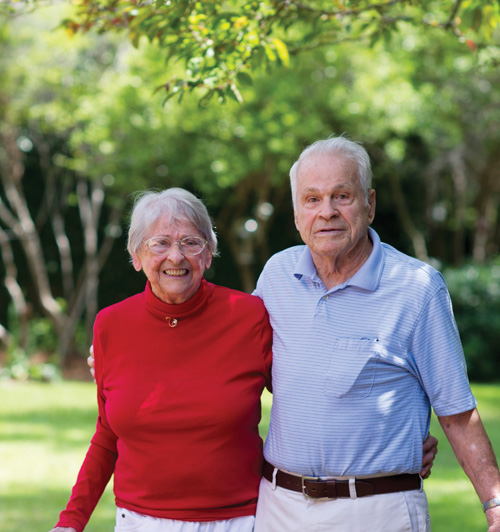|
by Dawn
Brazell
Public Relations
The residents at Bishop Gadsden
better watch out. Henry Brawner,
91, is back to the poker table and
more like his old self thanks to a
transcatheter aortic valve
replacement procedure that was
done March 29.
MUSC was the first in South
Carolina to perform the implant,
done through a minimally invasive
procedure that is now a new option
for patients previously considered
too sick to undergo traditional
valve replacement surgery. The
procedure can be done instead of
traditional, open-heart surgery.
Brawner said his results have
been very close to a miracle and
he has been amazed by the
transformation in his energy and
activity levels following the
procedure by Drs. Daniel H.
Steinberg and John S. Ikonomidis.
Having recovered quickly, Brawner
said he's glad he opted to try the
new procedure. He has enjoyed
resuming a more active lifestyle
and looks forward to celebrating
his 70th wedding anniversary in
December.
 Henry Brawner (right)
takes a stroll with his wife,
Francis. He likes that he can be
more active now since his TAVR
procedure. Henry Brawner (right)
takes a stroll with his wife,
Francis. He likes that he can be
more active now since his TAVR
procedure.
Ikonomidis, a cardiothoracic
surgeon and director of the South
Carolina Heart Valve Center at
MUSC, said the new valve enables
doctors to treat a new population
of patients with aortic valve
disease. "Since it involves a
minimally invasive procedure, TAVR
allows us to operate on patients
who are too frail or sick for open
valve replacement surgery."
The good news for patients is
that the Centers for Medicare and
Medicaid Services decided May 1 to
reimburse clinicians for
transcatheter aortic valve
replacement (TAVR) in inoperable
patients with severe aortic
stenosis. That will open the door
for more of these procedures to be
done.
TAVR involves an artificial valve
being threaded through a small
incision in the leg, and then
guided up to the heart through the
arteries. A small inflatable
balloon on the tip of the catheter
places the artificial valve in
place at the aortic opening,
replacing the natural heart valve.
The device is made from cow tissue
and polyester supported by a steel
frame.
Up to 1.5 million people in the
U.S. suffer from aortic stenosis,
a narrowing of the aortic valve,
which forces the heart to work
harder to pump blood and can lead
to heart failure, blood clots and
sudden death. Without an aortic
valve replacement, more than half
of patients diagnosed with aortic
stenosis would die within two
years after the onset of symptoms,
according to the FDA.
"We've been performing open-heart
valve replacements in patients for
decades, and for those patients,
the surgery can be
life-changing—significantly
improving and prolonging their
lives," said Ikonomidis. "Now we
can offer new hope to some of our
sicker valve patients, providing
them with a chance to live longer
and feel better, thanks to this
new procedure."
Brawner and his wife, Francis can
attest to that. His wife said her
husband was facing the prospects
of a motorized wheelchair, but now
he's back to all his usual
activities, including helping her
cook. "I was all for it because I
knew he was going downhill."
Meanwhile, in addition to his
poker games, Brawner said he's
back to shopping with his wife,
using the gym and just being more
active in general. He decided to
try the new procedure because he
was so fatigued and short of
breath all the time.
"I was having a hard time just
getting out of bed without pushing
up with my hands. Now I can just
pop up. It's a remarkable
difference."
|



 Henry Brawner (right)
takes a stroll with his wife,
Francis. He likes that he can be
more active now since his TAVR
procedure.
Henry Brawner (right)
takes a stroll with his wife,
Francis. He likes that he can be
more active now since his TAVR
procedure.